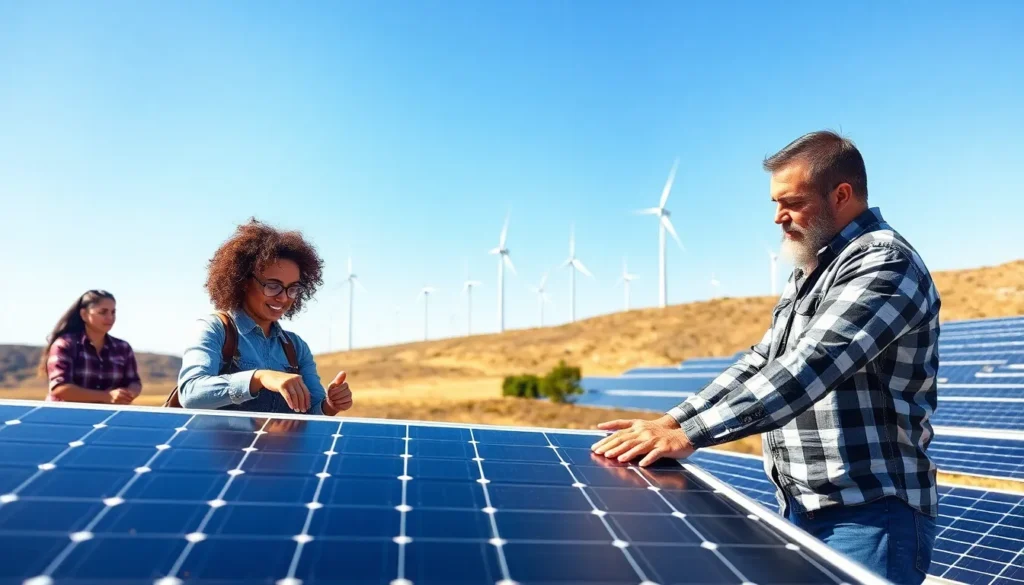Table of Contents
ToggleIn a world where fossil fuels are the grumpy old men of energy sources, clean energy technology is the fresh-faced millennial ready to shake things up. With climate change knocking at our door like an overzealous salesman, it’s time to embrace innovations that not only promise a greener planet but also save some serious cash. Who knew saving the Earth could be this exciting?
Overview of Clean Energy Technology
Clean energy technology encompasses a range of innovations designed to generate energy from renewable sources. Solar energy systems harness sunlight through photovoltaic cells, converting it into electricity. Wind turbines utilize kinetic energy from the wind, producing power with minimal environmental impact. Biomass energy relies on organic materials, like plant matter, to create sustainable fuel alternatives.
Geothermal energy exploits heat from beneath the Earth’s surface, offering a consistent energy source. Hydropower captures the energy of flowing water, generating electricity without greenhouse gas emissions. Each of these methods presents significant benefits, including reduced dependence on fossil fuels and lower carbon footprints.
Developments in energy storage, particularly batteries, improve the efficiency of clean energy systems. Enhanced grid management systems optimize energy distribution, ensuring reliability even during fluctuating demand. Innovations in energy efficiency technologies also play a crucial role by minimizing energy use in homes and businesses.
Government policies increasingly support clean energy initiatives, encouraging investment through incentives and subsidies. Transitioning to clean energy not only addresses climate change but also stimulates economic growth in emerging sectors. Job creation in renewable energy fields highlights the potential for a sustainable future.
Research and development continue to advance clean energy technologies, driving efficiencies and cost reductions. Collaborations between private companies, government bodies, and research institutions foster innovation, propelling the clean energy sector forward. The integration of these technologies will shape a more sustainable and resilient energy landscape.
Key Types of Clean Energy Technologies
Clean energy technologies include several innovative methods that leverage renewable resources to generate energy sustainably. The following subsections detail key types of these technologies.
Solar Energy
Solar energy harnesses sunlight through photovoltaic cells to produce electricity. This technology leads to massive reductions in carbon emissions. In 2022, solar power accounted for over 20% of new electricity generation capacity in the U.S. The installation of solar panels can provide energy independence for homeowners and reduce utility bills. As advancements continue, solar efficiency rates are expected to improve, making this energy source even more accessible.
Wind Energy
Wind energy captures kinetic energy from wind through turbines, converting it into electricity. This method represented about 9% of U.S. electricity generation in 2022. Wind farms can be built onshore or offshore, utilizing vast expanses of land or ocean to generate power. Costs have significantly decreased over the past decade, enhancing its attractiveness for investment. Ongoing technological upgrades improve turbine efficiency and capacity, optimizing energy output.
Hydropower
Hydropower generates energy through the movement of water, typically via dams or river systems. In 2022, this source contributed approximately 37% of renewable electricity generation in the U.S. Its efficiency remains unmatched, with the ability to produce large amounts of power consistently. Environmental concerns exist regarding ecosystem disruptions, yet advancements in fish-friendly turbine designs help mitigate impacts. Hydropower also enables energy storage, ensuring a reliable supply during fluctuating demand.
Geothermal Energy
Geothermal energy taps into heat from beneath the Earth’s surface to generate power. This technology offers a continuous source of energy, as Earth’s heat remains relatively stable. The potential for geothermal energy remains largely untapped in the U.S., with only a small percentage utilized. In regions with volcanic activity, such as California, geothermal plants can supply communities efficiently. Research continues into enhanced geothermal systems, promising even greater potential for future developments.
Biomass Energy
Biomass energy utilizes organic materials, such as plant and animal waste, to create energy. This approach contributes to waste reduction and offers a renewable source of fuel. In 2022, biomass accounted for about 5% of U.S. electricity generation. Various processes, including combustion and anaerobic digestion, convert biomass into electricity or biofuels. The integration of biomass technologies into existing energy systems enhances sustainability while supporting local economies.
Benefits of Clean Energy Technology
Clean energy technology offers numerous advantages that positively impact society and the environment. Understanding these benefits highlights the importance of transitioning to renewable energy sources.
Environmental Impact
Reduced greenhouse gas emissions significantly decrease the impact of climate change. Clean energy technologies, such as solar and wind, contribute to healthier air quality by eliminating harmful pollutants. Conservation of natural resources occurs when relying on renewables, preserving ecosystems for future generations. Reforestation initiatives often accompany biomass energy projects, helping restore degraded landscapes. Innovations in hydropower continuously work on minimizing environmental disruption while optimizing energy output. Together, these factors create a more sustainable approach to energy consumption.
Economic Advantages
Job creation flourishes in the clean energy sector as investments grow. Opportunities arise in manufacturing solar panels, wind turbines, and energy efficiency technologies. Lower operational costs for clean energy systems lead to substantial savings for consumers and businesses. Energy prices stabilize due to diversified energy sources, reducing dependence on fluctuating fossil fuel markets. Increased government funding and tax incentives support further research and development, fostering innovation. Overall, economic growth aligns closely with the expansion of renewable energy initiatives.
Energy Independence
Reduced reliance on foreign fossil fuels enhances national security. Clean energy sources promote energy independence, allowing countries to produce energy locally. Increased energy diversification decreases vulnerability to geopolitical tensions and market instability. Surplus energy can become an export opportunity, fostering economic partnerships. Distributed energy systems strengthen community resilience by reducing strain on centralized grids. In this way, clean energy technology not only benefits individual nations but also contributes to global energy stability.
Challenges Facing Clean Energy Technology
Clean energy technology faces significant challenges that impede its widespread adoption and effectiveness. These hurdles often stem from technological limitations, financial barriers, and policy and regulation issues.
Technological Limitations
Technological limitations hinder the scalability and efficiency of clean energy solutions. Energy storage systems often struggle to match the reliability of fossil fuels. Solar panels and wind turbines exhibit variance in output based on weather conditions. Geothermal energy deployment remains geographically restricted, limiting accessibility. Hydropower projects frequently encounter environmental concerns that complicate implementation. Each of these challenges requires innovation and research to overcome.
Financial Barriers
Financial barriers present major obstacles for clean energy technology adoption. High initial capital investments deter many stakeholders, including private companies and individuals. Lack of access to funding options further restricts smaller renewable projects. Operational costs remain competitive, but upfront expenses often outweigh perceived benefits. Investors may perceive uncertainties regarding long-term returns. Securing financial support through public-private partnerships could mitigate some of these challenges.
Policy and Regulation Issues
Policy and regulation issues severely impact the growth of clean energy technology. Inconsistent government incentives create a confusing landscape for stakeholders. Delays in permitting processes can stall renewable energy projects. Existing regulations may not favor innovative technologies, stifling widespread adoption. Without cohesive strategies, the transition to clean energy remains fragmented. Advocating for comprehensive policies can help streamline development and implementation.
Future Trends in Clean Energy Technology
Emerging technologies are reshaping the landscape of clean energy. Innovations such as enhanced solar panels and wind turbine designs promise increased efficiency. Energy storage advancements, particularly in battery technology, lead to greater reliability and capacity for renewable sources.
Smart grid technology continues to evolve. This transformation improves energy distribution and management, accommodating the variable nature of renewable energy. Artificial intelligence integration optimizes grid operations, ensuring stability even with fluctuating supply levels.
In policy-making, increased government investment in research and development plays a crucial role. This commitment fosters collaboration between private companies and public entities, driving innovation in renewables. Financial incentives aimed at stakeholders directly support the transition to cleaner energy alternatives.
Hydrogen energy is gaining traction as a versatile energy carrier. It offers potential for both transportation and energy storage, complementing existing clean technologies. Interest in hydrogen production through renewable processes aligns with climate goals and helps bolster energy independence.
Electric vehicles (EVs) are enhancing the clean energy narrative. They encourage greater adoption of clean energy as charging infrastructure develops alongside advancements in battery technology. Renewable energy sources, paired with increased EV usage, contribute to a reduction in greenhouse gas emissions.
Geothermal energy also stands at the forefront of future developments. Tapping into Earth’s thermal energy offers a reliable and stable resource, with ongoing explorations revealing significant untapped potential. Biomass energy remains noteworthy, as it aligns waste reduction with energy production, fostering sustainable practices.
Overall, investments in clean energy technologies not only address climate change but also promote economic growth. Solutions emerging within this sector will shape a sustainable future, emphasizing the importance of continued research and development.
Conclusion
The shift towards clean energy technology marks a pivotal moment in addressing global challenges. This transition not only mitigates climate change but also fosters economic growth and energy independence. As innovations continue to emerge and evolve, the potential for a sustainable energy future becomes increasingly attainable.
Investment in clean energy solutions is essential for overcoming existing barriers and unlocking further advancements. With collaboration among governments, industries, and research institutions, the path forward looks promising. Embracing these technologies not only benefits the environment but also enhances societal well-being, paving the way for a resilient and prosperous future.








